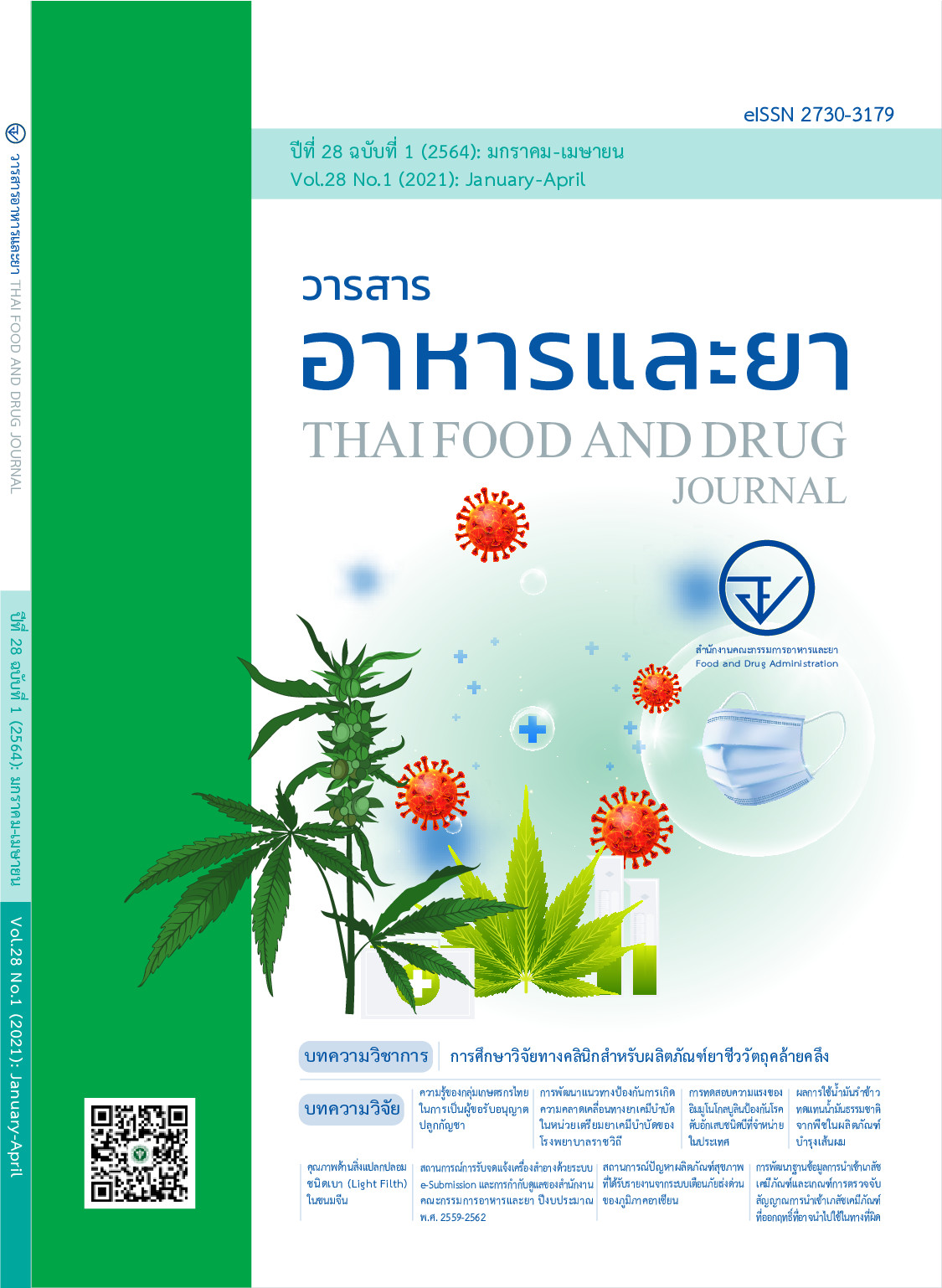ผลการใช้น้ำมันรำข้าวทดแทนน้ำมันธรรมชาติจากพืชในผลิตภัณฑ์บำรุงเส้นผม
Main Article Content
บทคัดย่อ
ความสำคัญ: น้ำมันธรรมชาติจากพืชแต่ละชนิดมีองค์ประกอบกรดไขมันที่มีลักษณะเฉพาะ ขึ้นอยู่กับแหล่งที่มาของพืช ซึ่งมีผลต่อคุณสมบัติทางกายภาพของเส้นผม โดยกรดไขมันอิ่มตัว และกรดไขมันไม่อิ่มตัวตำแหน่งเดียวสามารถซึมเข้าสู่เส้นผม ซึ่งช่วยบำรุงโครงสร้างภายในเส้นผมให้มีความแข็งแรง และยืดหยุ่น กรดไขมันไม่อิ่มตัวหลายตำแหน่งช่วยเคลือบเส้นผมทำให้มีความเงางาม นุ่มลื่น จัดทรงง่าย
วัตถุประสงค์: เพื่อศึกษาผลทางกายภาพ เคมี ความคงตัว และความชอบของผลิตภัณฑ์น้ำมันบำรุงเส้นผม และผลิตภัณฑ์นวดผม จากการใช้น้ำมันรำข้าวทดแทนน้ำมันธรรมชาติจากพืช
วิธีการวิจัย: ทดลองในห้องปฏิบัติการ โดยตั้งสูตรตำรับผลิตภัณฑ์น้ำมันบำรุงเส้นผม 2 สูตรที่มีส่วนประกอบ น้ำมันรำข้าวกับสูตรน้ำมันอาร์แกน และสูตรตำรับผลิตภัณฑ์นวดผม 2 สูตรที่มีส่วนประกอบน้ำมันรำข้าวผสมน้ำมันมะกอกและน้ำมันสวีทอัลมอนด์ กับสูตรน้ำมันมะกอกผสมน้ำมันสวีทอัลมอนด์ จากนั้นเปรียบเทียบคุณสมบัติทางกายภาพและทางเคมี ได้แก่ สี กลิ่น ลักษณะเนื้อของผลิตภัณฑ์ ค่าความเป็นกรด-ด่าง (pH) และความหนืด รวมทั้งทดสอบความชอบของผู้ใช้ผลิตภัณฑ์น้ำมันบำรุงเส้น 20 คน และผลิตภัณฑ์นวดผม 27 คน ด้วยการทดสอบความชอบแบบ 9-point hedonic scale
ผลการศึกษา: พบว่าผลิตภัณฑ์น้ำมันบำรุงเส้นผมและนวดผม มีลักษณะทางกายภาพ และทางเคมี รวมทั้งความชอบผลิตภัณฑ์ ไม่แตกต่างกันอย่างมีนัยสำคัญ จากสูตรน้ำมันอาร์แกน และสูตรน้ำมันมะกอกผสมน้ำมันสวีทอัลมอนด์ ในทุกคุณลักษณะ การทดสอบความคงตัวของผลิตภัณฑ์น้ำมันบำรุงเส้นผม และผลิตภัณฑ์นวดผมที่มีส่วนประกอบของน้ำมันรำข้าว พบว่ามีความคงตัวเพียงพอสำหรับใช้เป็นส่วนประกอบในผลิตภัณฑ์
สรุป: น้ำมันรำข้าวมีความเหมาะสมสำหรับใช้เป็นสารให้ความนุ่มลื่นในผลิตภัณฑ์น้ำมันบำรุงเส้นผมและผลิตภัณฑ์นวดผม โดยสามารถใช้แทนน้ำมันธรรมชาติจากพืชในปริมาณร้อยละ 100 ในผลิตภัณฑ์น้ำมันบำรุงเส้นผม และร้อยละ 75 ในผลิตภัณฑ์นวดผม ผลการศึกษานี้นำไปสู่การลดต้นทุนการนำเข้าวัตถุดิบจากต่างประเทศได้อีกด้วย
Article Details

อนุญาตภายใต้เงื่อนไข Creative Commons Attribution-NonCommercial-NoDerivatives 4.0 International License.
เอกสารอ้างอิง
Marsh JM, et al. Role of Internal Lipids in Hair Health. Journal of the Society of Cosmetic Chemists [Internet]. 2018;69:347-56. PMID: 30767883.
Science-y Hair Blog. Oils – which ones soak in vs. coat the hair? [Internet]. 2016 [cited 2019 May 7]. Available From: http://science-yhairblog.blogspot.com/2013/06/oils-which-ones-soak-in-vs-coat-hair.html
Dias MFRG. Hair cosmetics: an overview. Int J Trichology 2015;7(1):2-15. doi: 10.4103/0974-7783.153450.
Rele AS, Mohile RB. Effect of mineral oil, sunflower oil, and coconut oil on prevention of hair damage. J Cosmetic Sci 2003;54(2):175–92. PMID: 12715094.
Fregonesi A, et al. Brazilian oils and butters: The effect of different fatty acid chain composition on human hair physiochemical properties. J Cosmetic Sci 2009;60(2):273-80. PMID: 19450426.
In-cosmetics asia. Top trends and opportunities in haircare: global data [Internet]. 2018 [cited 2019 May 7]. Available From: https://asia.in-cosmetics.com/RXUK/RXUK_In CosmeticsAsia/2018/Marketing_Trends_2018/Day_1_12.00_Sumit_Chopra_GlobalData_OK.pdf?v=636764113969516420
Zielinska A, Nowak I. Fatty acids in vegetable oils and their importance in cosmetic industry. Chemik 2014;68:103-10. [cited 2019 Jul 14]. Available from: https://www.researchgate.net/publication/286712435_Fatty_acids_in_vegetable_oils_and_their_importance_in_cosmetic_industry
Science-y Hair Blog. Product pH List [Internet]. 2018 [cited 2019 May 7]. Available From: http://science-yhairblog.blogspot.com/2018/12/product-ph-list.html
กระทรวงอุตสาหกรรม. ประกาศกระทรวงอุตสาหกรรม ฉบับที่ 4965 (พ.ศ. 2560) เรื่อง กำหนดมาตรฐานผลิตภัณฑ์อุตสาหกรรม ผลิตภัณฑ์นวดผมชนิดล้างออก. ราชกิจจานุเบกษา เล่ม 164, ตอนพิเศษ 106 ง (ลงวันที่ 14 กุมภาพันธ์ 2560).
Making Cosmetics. Stability testing of cosmetics [Internet]. Redmond WA: Making Cosmetics. [cited 2019 Oct 7]. Available From: https://www.makingcosmetics.com/Stability-Testing-of-Cosmetics_ep_59.html
CTFA and Colipa. Guidelines on stability testing of cosmetic products [Internet]. Cosmetics Europe; 2004 [cited 2019 Jul 14]. Available from: https://www.cosmeticseurope.eu/files/5914/6407/8121/Guidelines_on_Stability_Testing_of_Cosmetics_CE-CTFA_-_2004.pdf


